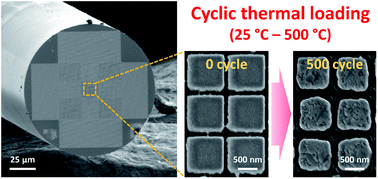当前位置:
X-MOL 学术
›
Nanoscale Adv.
›
论文详情
Our official English website, www.x-mol.net, welcomes your feedback! (Note: you will need to create a separate account there.)
Thermal deformation of gold nanostructures and its influence on surface plasmon resonance sensing
Nanoscale Advances ( IF 4.7 ) Pub Date : 2019/12/27 , DOI: 10.1039/c9na00714h Hyun-Tae Kim 1 , Mayank Pathak 1 , Keshav Rajasekaran 1 , Ashwani K Gupta 1 , Miao Yu 1
Nanoscale Advances ( IF 4.7 ) Pub Date : 2019/12/27 , DOI: 10.1039/c9na00714h Hyun-Tae Kim 1 , Mayank Pathak 1 , Keshav Rajasekaran 1 , Ashwani K Gupta 1 , Miao Yu 1
Affiliation

|
Plasmonic nanostructures have been recently used in elevated temperature applications such as sensing of high-energy systems and localized heat generation for heat-assisted magnetic recording, thermophotovaltaics, and photothermal therapy. However, plasmonic nanostructures exposed to elevated temperature often experience permanent deformations, which could significantly degrade performance of the plasmonic devices. Therefore, understanding of thermal deformation of plasmonic nanostructures and its influence on the device performance is essential to the development of robust high-performance plasmonic devices. Here, we report thermal deformation of lithographic planar gold nanopatch and nanohole arrays and its influence on surface plasmon resonance sensing. The gold nanostructures are fabricated on a silicon substrate and on the end-face of an optical fiber using electron-beam lithography and focused-ion-beam lithography, respectively. The fabricated gold nanostructures are exposed to cyclic thermal loading in the range of 25 °C to 500 °C. Through experimental and numerical studies, we investigate (i) thermal deformation modes of the gold nanostructures, (ii) influence of the gold nanostructure geometry on the degree and mechanism of the thermal deformation, and (iii) influence of the thermal deformation on performance of surface plasmon resonance sensing. The obtained understanding from these studies is expected to help guide the development of robust high-performance plasmonic sensors for monitoring in elevated temperature environments. Although the current work is focused on gold nanostructures, it can be extended to provide useful insights on thermal deformation of refractory plasmonic nanostructures at extreme temperature.
中文翻译:

金纳米结构的热变形及其对表面等离子体共振传感的影响
等离子体纳米结构最近已用于高温应用,例如高能系统的传感和用于热辅助磁记录的局部发热、热光伏和光热疗法。然而,暴露在高温下的等离子体纳米结构经常会发生永久变形,这可能会显着降低等离子体器件的性能。因此,了解等离子体纳米结构的热变形及其对器件性能的影响对于开发稳健的高性能等离子体器件至关重要。在这里,我们报告了光刻平面金纳米贴片和纳米孔阵列的热变形及其对表面等离子体共振传感的影响。金纳米结构分别使用电子束光刻和聚焦离子束光刻在硅基板和光纤端面上制造。制造的金纳米结构暴露于 25°C 至 500°C 范围内的循环热负荷。通过实验和数值研究,我们研究了(i)金纳米结构的热变形模式,(ii)金纳米结构几何形状对热变形程度和机制的影响,以及(iii)热变形对性能的影响。表面等离子共振传感。从这些研究中获得的理解有望帮助指导开发强大的高性能等离子体传感器,用于在高温环境中进行监测。虽然目前的工作主要集中在金纳米结构上,
更新日期:2020-03-19
中文翻译:

金纳米结构的热变形及其对表面等离子体共振传感的影响
等离子体纳米结构最近已用于高温应用,例如高能系统的传感和用于热辅助磁记录的局部发热、热光伏和光热疗法。然而,暴露在高温下的等离子体纳米结构经常会发生永久变形,这可能会显着降低等离子体器件的性能。因此,了解等离子体纳米结构的热变形及其对器件性能的影响对于开发稳健的高性能等离子体器件至关重要。在这里,我们报告了光刻平面金纳米贴片和纳米孔阵列的热变形及其对表面等离子体共振传感的影响。金纳米结构分别使用电子束光刻和聚焦离子束光刻在硅基板和光纤端面上制造。制造的金纳米结构暴露于 25°C 至 500°C 范围内的循环热负荷。通过实验和数值研究,我们研究了(i)金纳米结构的热变形模式,(ii)金纳米结构几何形状对热变形程度和机制的影响,以及(iii)热变形对性能的影响。表面等离子共振传感。从这些研究中获得的理解有望帮助指导开发强大的高性能等离子体传感器,用于在高温环境中进行监测。虽然目前的工作主要集中在金纳米结构上,



























 京公网安备 11010802027423号
京公网安备 11010802027423号